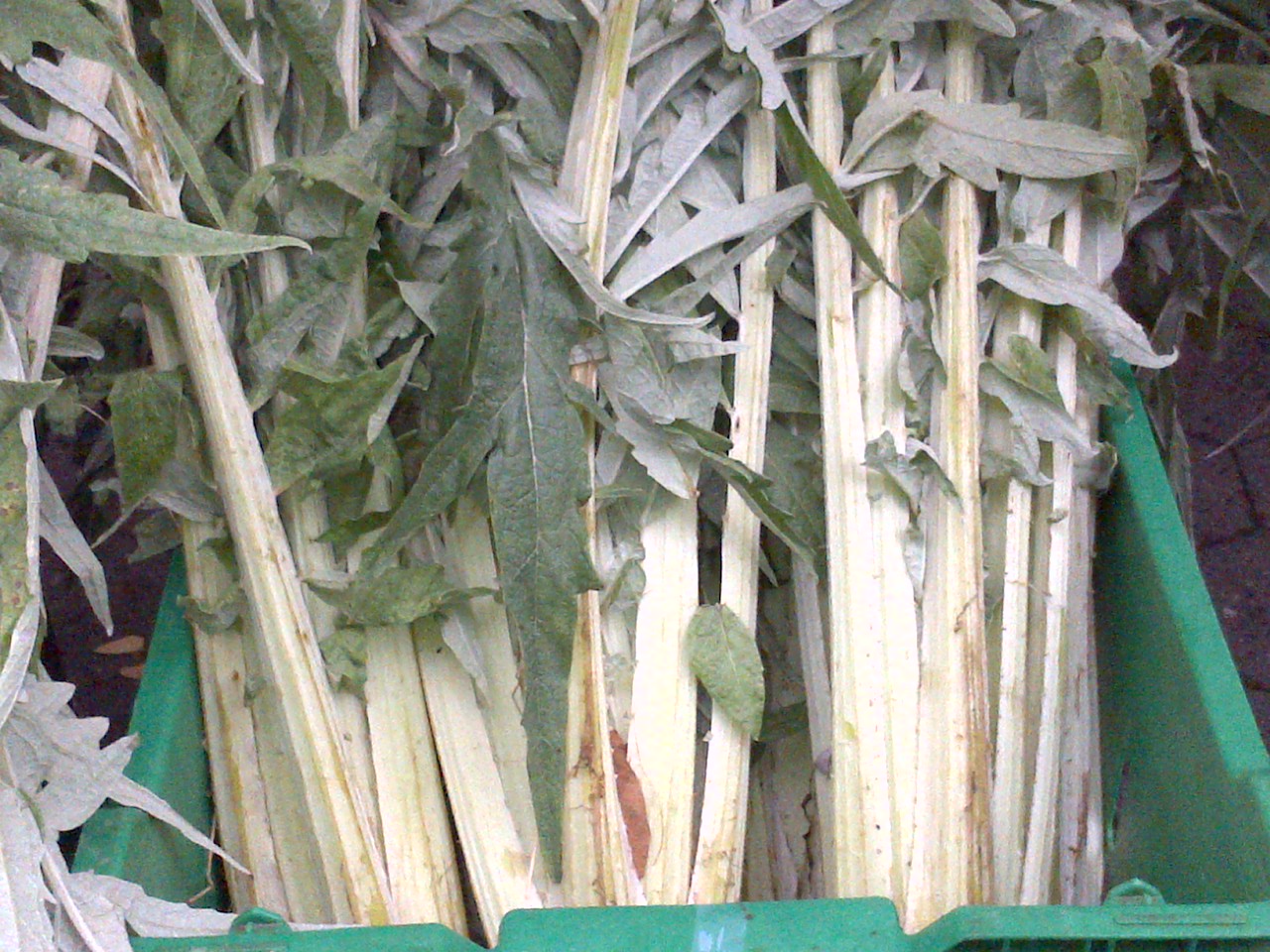What the heck was this vegetable?
If I had seen the plant growing out of the ground I might not have even assumed it was edible, but it was in a bin at the Union Square Farmers Market, so I asked the farmer.
 |
| Really, what the heck is that? |
Cardoons, he said.
I had never heard of cardoons. I liked the sound of the word. I could easily imagine it in the history books: "The king was overthrown in the Cardoon Revolution of 1658." The farmer told me that cardoons tasted a bit like artichokes and grow like crazy.
I consulted my well-thumbed copy of The Oxford Companion to Food.
 |
| A book that I gave as a gift, but I ended up using all the time |
I learned that the cardoon was
a member of the thistle family, with a flower head intermediate in size and appearance between artichoke and common thistle. Long before the artichoke was developed, the ancient Greeks and Romans regarded the cardoon as a great delicacy.
So far so good. The book went on to advise,
The flowering heads, stems and midribs of the main leaves are eaten.The flavor is complex. bitter and sweet, with limits of artichoke hearts, celery and oyster plants...Still popular in Spain and Italy, [cardoons are regarded as] a troublesome weed in South America, Australia and California.
I sometimes ponder the old vegetable-or-weed conundrum, especially when I buy dandelion greens or purslane (hmm....perhaps a blog entry is in order, or maybe trademarking this great party game), but cardoons looked much more substantial than the weeds I know. Their root systems looked like they could get pretty entrenched. I could easily imagine one saying, "I SAID, this is my garden now." Eating them seemed like basic self-defense.
I brought the cardoons home, washed them thoroughly and put them on the chopping block.
Some of the outer stalks needed some trimming. I enjoyed the feathery appearance of some of the leaves.
I pondered what to do with my cardoons. A quick internet search revealed that in the wild, cardoons have a beautiful flower head and massive spikes. Cardoons are known as cardone (make that "car-doh-nay") in Italy, where both their stalks and flower buds are popular. Cardone are made into soups and stews; battered and fried; and used in risotto. They are featured prominently in bagna cauda, a fondue-like dish in which raw and boiled vegetables get dipped in a hot bath of garlicky olive oil or melted butter. In the US, they're apparently snapped up by those in the know - folks who come from Mediterrean countries in which cardoons are popular - and totally ignored by everyone else.
Since this was my first adventure, I thought I'd saute/steam the cardoons in a skillet, and consider whipping up a kind of vegetarian (anchovy-free) bagna cauda if I felt motivated.
Since this was my first adventure, I thought I'd saute/steam the cardoons in a skillet, and consider whipping up a kind of vegetarian (anchovy-free) bagna cauda if I felt motivated.
I had read some recipes that suggested braising the cardoons for an hour, but I declared the cardoons ready for consumption after about 15 minutes.
The verdict: Okay. Kind of tasty. Quicker to cook than artichokes but with a smaller payoff. The taste was as The Oxford Companion said, artichoke + celery hearts.
The food writer Deborah Madison called the vegetable "the difficult cardoon" and suggested "rich embellishments" like cream, eggs and cheese. She noted that her guests liked a cardoon salad she served well enough, but "didn't feel that it warranted the effort involved." Her response - "feature cardoons in a course devoted only to them" - made me laugh. You brat! You're an overpriced non-entity, but if I devote enough attention to you my guests will understand that you're worth my considerable investment of money (as Madison also notes, "cardoons are expensive") and time.
Reading between the lines, I would have concluded that cardoons are on the "forgotten vegetables" list for good reason, and that I was unlikely to encounter them, at least in New York, except as a farmers' market curiosity.
But once again I failed as a Produce Trend Spotter. Soon after my cardoon experiment, I spied them on a supermarket shelf, looking right at home, occupying their space with no particular fanfare. No introductory signs, no testimonials, no ingratiating recipe suggestions to entice the unfamiliar to take a risk on an mystery product.
And even more amazingly, they were wearing jaunty produce code rubber bands that suggested that they were here to stay.





No comments:
Post a Comment